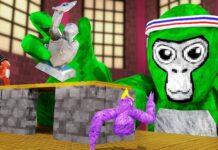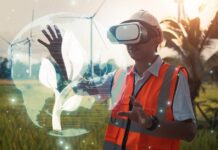Geology and Virtual Reality:
A Symbiotic Relationship in Production and Education
By
Jayce Calder, Nic Bjerstedt, Danny Reimer, Nicholas Kinar
As a group, we have a combined interest in both geology and technology. So, for our project we decided to combine the two areas, focus in on virtual reality, and investigate two topics. The first question we wanted to explore was how geology played a role in the creation of VR headsets, such as the minerals that are used in the production of headsets with a brief focus on economic geology. Secondly, we wanted to incorporate education into our research and look at how virtual reality could be integrated into teaching geology. Our belief going into our research was that virtual reality could be beneficial in educating students about geology and improve the ability of students to learn the topics.
In a virtual reality headset, there are few parts that use minerals as the “ingredients” aside from the circuitry within the headset that would obviously contain things like copper. Other than electronics, virtual reality headsets use a lot of plastic, or a similar material depending on the specific headset in places such as the exterior case. Although, one specific part that is made up of many minerals is the screen. Virtual reality headsets usually use one of two kinds of displays: OLED or LCD (“Virtual Reality”).
In OLED displays, the anode is made of a conductor such as indium tin oxide for its conductivity and optical transparency (“OLED – Organic Light Emitting Diode”). Indium tin oxide is, not surprisingly, a composition of indium, tin, and oxygen that is used widely in electronics production (“Indium Tin Oxide”). Additionally, the emissive layer, which transports electrons from the cathode, can be made from many different organic materials, although a common one is aluminum (“OLED – Organic Light Emitting Diode”). Along with use as the emissive layer in OLED displays, aluminum is widely used in many other products because of its properties and the fact that it is “the most abundant metallic element in [the] Earth’s crust” (“Aluminum” [Royal Society of Chemistry]; “Aluminum” [Britannica]).
The minerals used in the production of virtual reality headsets are beneficial to economic geology. Like most minerals, aluminum and indium can be mined and sold to be used in the production of products, sometimes virtual reality headsets. Although, most of the production of both indium and aluminum comes from China (“Indium”; Natural Resources Canada). For indium production, China produces just under half of the world’s indium, with some contribution from other countries including Canada (“Indium”). On the other hand, China produces over half of the world’s aluminum, with Canada contributing as well (Natural Resources Canada). Therefore, these minerals are used all around the world in varying ways, including the production of virtual reality headsets, while also contributing to the economic impact of geology.
In education, virtual reality can be a helpful tool in encouraging learning and improving performance from students. There have been many studies conducted which examine the use of virtual reality in education. It is found to help (in tandem with activities that include student interaction) the development of useful thought processes for learning in primary education students (Sulisworo et al. 6). Additionally, virtual reality has been tested in other levels of education. For example, VR has been found to improve the quality of teaching in post-secondary engineering courses at certain Chinese institutions (F. Lei et al. 15). Utilizing this more interactive way of educating students challenges them to further develop their ways of thinking into more sophisticated methods (F. Lei et al. 15).
A key aspect of education is learning through theoretical models and real experience, but this can be a challenge to bridge the gap between the two. However, it has been found that virtual reality can make combining the two subjects easier. In one study, a group of students was put through a geology lesson utilizing a VR system, and it was found to increase the students’ motivation and learning abilities (Chang 14). As can be seen, using virtual reality as an educational tool can improve any shortcomings that come along with traditional teaching methods and provide students with an engaging way of learning. Overall, an increase in performance can be seen if students have an easier time combining two different ways of thinking. The graph below shows four different learning groups with the vertical axis representing test scores and the horizontal axis representing the thirty students in each group (W. Lei et al. 12).
Virtual reality can be seen in many ways within the field of geology such as the minerals used in the production of VR headsets and as a useful tool in education. Two minerals commonly used to produce VR headsets, indium and aluminum, are also great contributors to economic geology. Additionally, there is lots of data which supports virtual reality as a helpful tool in education because it can increase student performance, learning, and motivation, showing how virtual reality and geology can be tied together in more ways than one.
Works Cited
“Aluminum.” Britannica, 25 Feb. 2024, https://www.britannica.com/science/aluminum.
“Aluminum.” Royal Society of Chemistry, n.d., https://www.rsc.org/periodic-table/element/13/aluminium.
Chang, Shao-Chen, et al. “Effects of Applying a VR-Based Two-Tier Test Strategy to Promote Elementary Students’ Learning Performance in a Geology Class.” British Journal of Educational Technology, vol. 51, no. 2, 2019. http://dx.doi.org/10.1111/bjet.12790.
“Indium.” ACS, n.d., https://www.acs.org/greenchemistry/research-innovation/endangered-elements/indium.html.
“Indium Tin Oxide.” Wikipedia, The Free Encyclopedia, Wikimedia Foundation, 4 Apr. 2024, https://en.wikipedia.org/wiki/Indium_tin_oxide.
Li, Fei, et al. “Application of Sustainable Development of Teaching in Engineering Education: A Case Study of Undergraduate Course Design of Raman Spectroscopy Based on Virtual Reality (VR) Technology.” Sustainability, vol. 15, no. 3, 2023. https://doi.org/10.3390/su15031782.
Li, Wenjuan, et al. “VR-Enhanced Cognitive Learning: Method, Framework, and Application.” Applied Sciences, vol. 13, no. 8, 2023. https://doi.org/10.3390/app13084756.
Natural Resources Canada. “Aluminum Facts.” Government of Canada, 7 Nov. 2023, https://natural-resources.canada.ca/our-natural-resources/minerals-mining/mining-data-statistics-and-analysis/minerals-metals-facts/aluminum-facts/20510.
“OLED – Organic Light Emitting Diode.” New Haven Display International, 29 Jan. 2023, https://newhavendisplay.com/blog/oled-organic-light-emitting-diode-/.
Sulisworo, Dwi, et al. “The Feasibility of Enhancing Environmental Awareness Using Virtual Reality 3D in the Primary Education.” Education Research International, vol. 2022, 2022. https://doi.org/10.1155/2022/4811544.
“Virtual Reality.” Wikipedia, The Free Encyclopedia, Wikimedia Foundation, 4 Apr. 2024, https://en.wikipedia.org/wiki/Virtual_reality.


